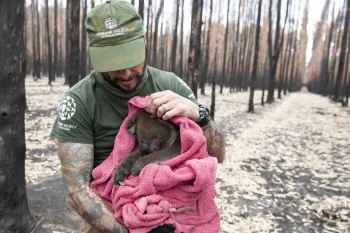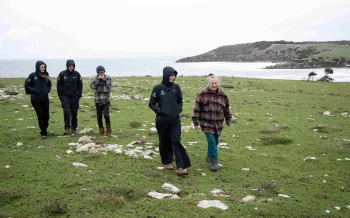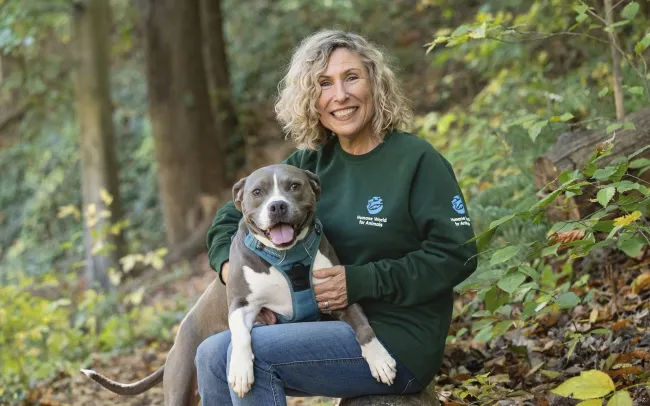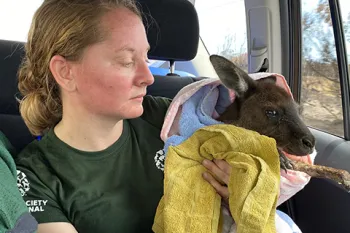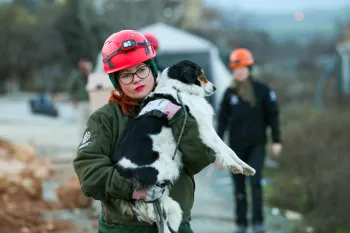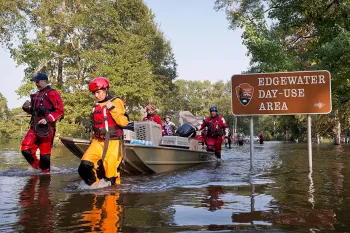“Every time we found an animal alive, it felt like a miracle.” That’s what Adam Parascandola, now vice president of the Animal Rescue Team here at Humane World for Animals, said after returning from Kangaroo Island in early 2020.
News of the devastating bushfires that had killed or displaced an estimated 3 billion animals and reduced parts of Australia’s thriving, vibrant landscape to a grey vastness of ash would soon be eclipsed by news of COVID-19, which would become, as we all know, a worldwide pandemic.
We have never forgotten Kangaroo Island. Our team of rescuers spent several weeks searching for and rescuing injured and displaced animals from the smoldering landscape, rushing many to urgent veterinary treatment, transporting others to local facilities for care and providing watering stations for unseen survivors of the catastrophe.
We would continue to provide support for the care and rehabilitation of animals we rescued and others coming to local rescue centers. We visited wildlife rehabilitation facilities on the island to assess additional needs and tried to address those. We returned in March the same year to take part in and learn more about the release of rescued animals and for discussions of future work (disrupted by the pandemic).
That was five years ago. This past month, members of our team returned to Kangaroo Island to see how the environment has recovered since then and to reflect on what we accomplished there.
One strongly positive outcome in the aftermath of the disaster was the creation of disaster response programs within Humane World for Animals Australia, then known as Humane Society International Australia. Today, that program coordinates with hundreds of sanctuary and carer networks to help them to prepare for future disasters and actively advocates for the inclusion of animal-related concerns in the wider Australian disaster network. In the years following the wildfire, there was an increase in academic research on the effects of disasters, and the program has helped to shape that research agenda with its input while directly supporting the wildlife rescue and rehabilitation sector to build capacity.
At Humane World for Animals, we are focused on ending animal suffering everywhere. As part of that work, we have rescued or otherwise helped tens of thousands of animals during disasters around the world. Since our historic commitments in the aftermath of the 2004 Indian Ocean Rim tsunami and 2005’s Hurricane Katrina, we have prioritized an approach involving rapid response, near-term recovery efforts and long-term resilience initiatives. In those two instances we made substantial use of donated funds to rebuild valuable humane infrastructure and launch long-lasting animal welfare initiatives with shelter partners and veterinary institutions. It is not an exaggeration to say that the work that we do during these “blue sky days” saves lives.
So many ways to help
Last year alone, we answered the call to help animals and people impacted by Hurricanes Helene and Milton in the U.S., Hurricanes John and Milton in Mexico, and disasters in India, Viet Nam, Nepal, Chile, Brazil and Ecuador, where we deployed or provided funds to help.
Our team is highly trained and ready to deploy at a moment’s notice.
Our deployments can involve from five to 20 responders, depending on the type of assistance requested. We often start with a small assessment team and build out from there. For longer deployments, such as the Türkiye earthquakes in 2023, we also rotate deployment teams.
For us to be able to help in a disaster area, there must be an official request from the appropriate agency or emergency official. While we will proactively check in with local groups about any needs they have, we can only deploy a rescue team when there is a formal request. This is vitally important: These protocols are in place to ensure there is no chaos created by outside groups coming in unrequested, and to ensure the assistance is sent to where it is needed most.
For example, if rescuers arrive without being requested, they might end up removing lost pets from an area, which could hurt the chances of reunifications with their families, or they might find themselves in situations where they need to be rescued, themselves, from a dangerous situation. Unapproved deployments also risk filling up local hotels and camping sights, which can be in high demand while people who have had to evacuate from their damaged homes need somewhere to go. It can also compromise official responders who also need places to stay.
With some disasters, such as hurricanes, we know they are coming; we initially check in with local authorities before a storm makes landfall to see if pre-storm evacuation assistance is needed. After a storm makes landfall, we are on standby for a deployment request for search and rescue, emergency sheltering, supplies or veterinary care, depending on the country and scale of need.
If we do deploy a rescue team, our work includes search-and-rescue efforts to find animals stranded or trapped by floods, rubble, fires and other hazards. We also provide essential supplies and veterinary care, which typically includes setting up pop-up veterinary clinics and distribution points. Creating temporary shelters gives animals a safe place to receive care. Shelter animals who were up for adoption in a disaster zone can be transported to shelters outside the affected area that have room for them. This can make a world of difference for shelters in storm-ravaged areas, giving them time to recover from the crisis and assess the damage.
Deploying a rescue team is not the only way to help, though. We provide emergency grants to partner groups on the ground and remote assistance with lifesaving equipment. Our grants to local groups provide pet food and animal feed, veterinary drugs and supplies, veterinary equipment enabling lifesaving surgeries on site, rehabilitation for affected wildlife, and the tools and supplies needed to reinforce or rebuild shelters and rehabilitation wildlife centers.
As some of our responders head into crisis zones to comb through the rubble, other colleagues are actively working on changing the system so that animals can be included in disaster planning. For example, as the years just after Katrina showed the importance of the human-animal bond in disaster response worldwide, we advocated for a federal law to support the inclusion of animals in disaster-related planning, which passed just two years after Katrina struck.
People and animals are in this together
At the core of this work is the acknowledgement that the well-being of people is closely tied to the well-being of animals. Too often, in disasters around the world, we’ve seen people who care deeply for their animals but do not have a preparedness plan for disaster, or access to the tools, infrastructure and support to safely evacuate with them. This can be a matter of life or death.
For example, during Hurricane Florence in North Carolina, we arrived to help a family who had been found still in their home with their pets; they were awaiting rescue because they didn't have the resources to evacuate as floodwaters rose. We saw this a lot during Katrina, as well. Because people’s pets are part of their families, disaster response must account for caring for and taking in pets; otherwise, many people will endanger themselves rather than leave their animals behind.
The close connection between people and animals is most obviously seen with these situations relating to pets, but it is hardly the end of the story. We work to save all animals in need—from koalas and kangaroos in the Australian wildfires to cows and goats during dramatic floods in India.
Over and over, we have seen that the fates of people and animals are intimately linked. Floods, wildfires, volcano eruptions, earthquakes and tornadoes don’t discriminate; people, pets, wildlife and farmed animals are in it together. It is an honor that for so many years we have been able to help so many thousands of people and animals in the wake of disaster. And we are determined to continue this vital work.
I am proud that we have grown our disaster and emergency response capabilities to such an extent that we can now deploy in multiple situations simultaneously throughout the world. This is something we have been working toward for a long time, and it is a critical element of our service to animals. In more than half a century of meeting animal-related disaster needs across the globe, we have rescued and transported tens of thousands of animals to safety, partnered with countless communities and local organizations in their own response efforts, trained generations of rescue personnel and volunteers, and developed advanced protocols for rapid assessment, resource mobilization and animal care.
As data about climate change shows there is an increase in intensity and frequency of disasters, we have been increasing our capacity to respond. The deep sense of connection that we share across species can bring vital comfort to all in even the darkest hours.
